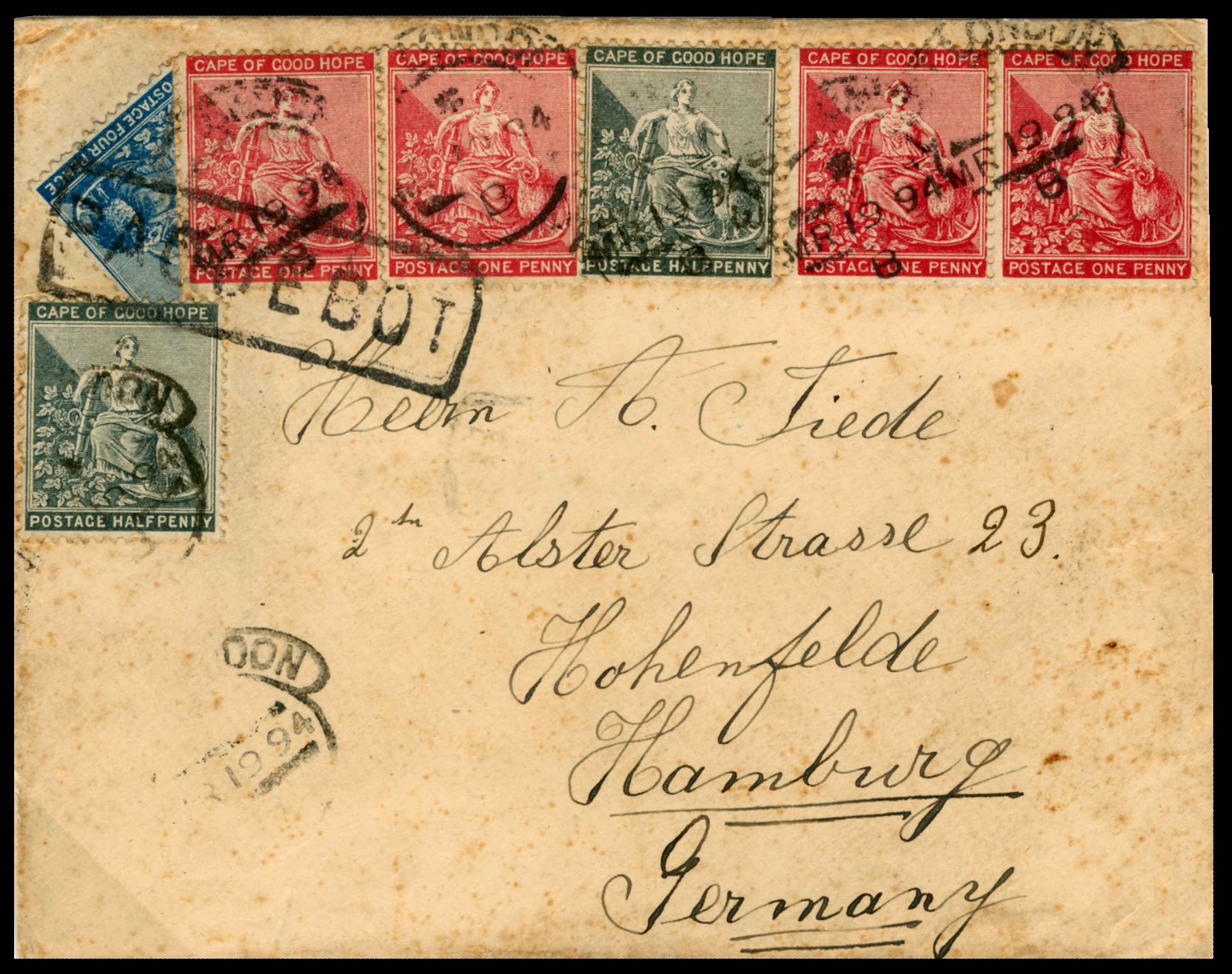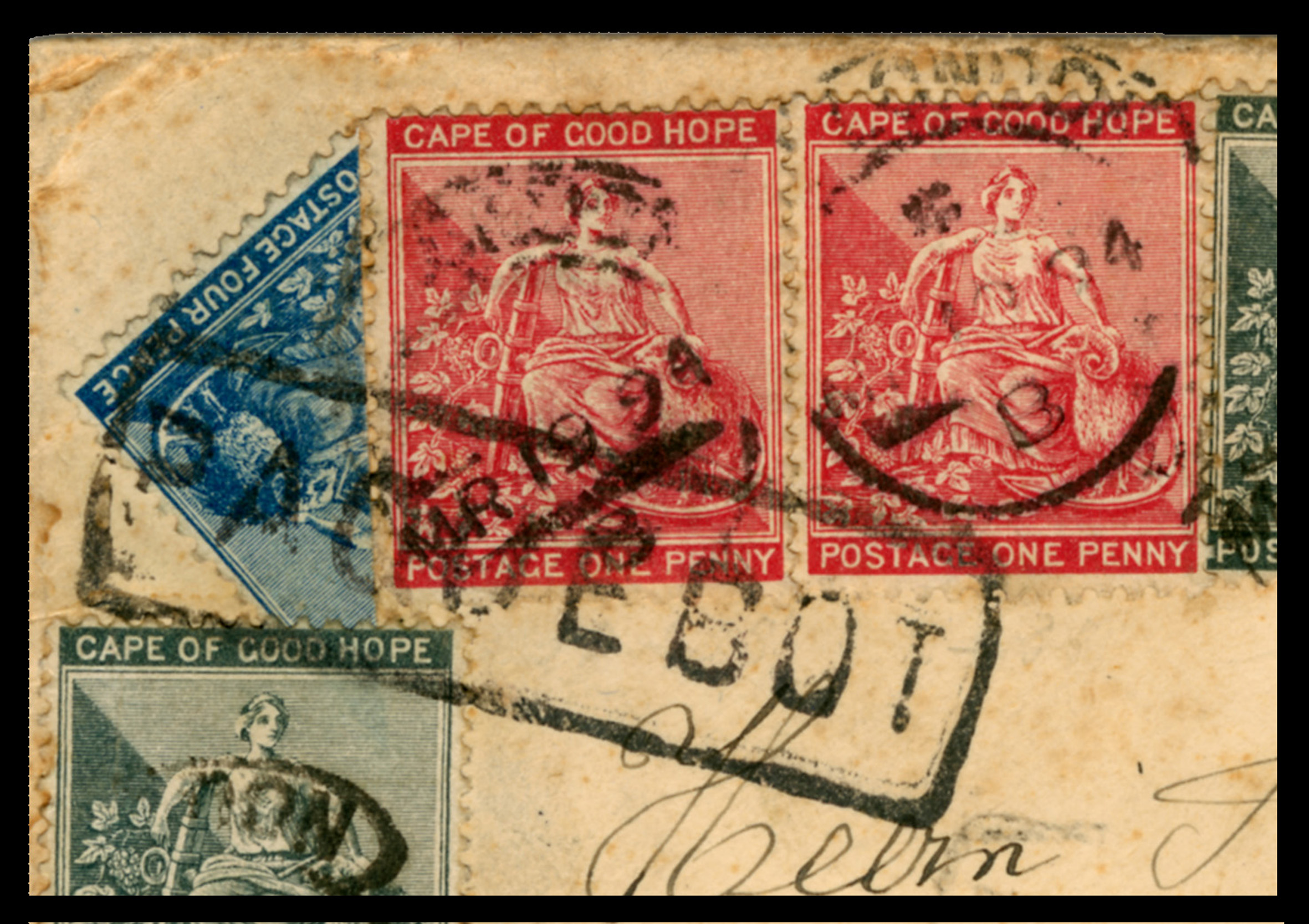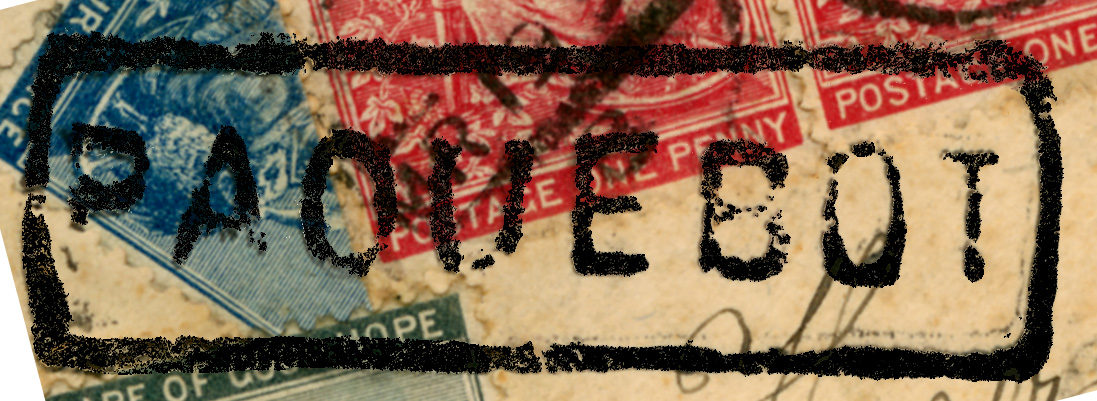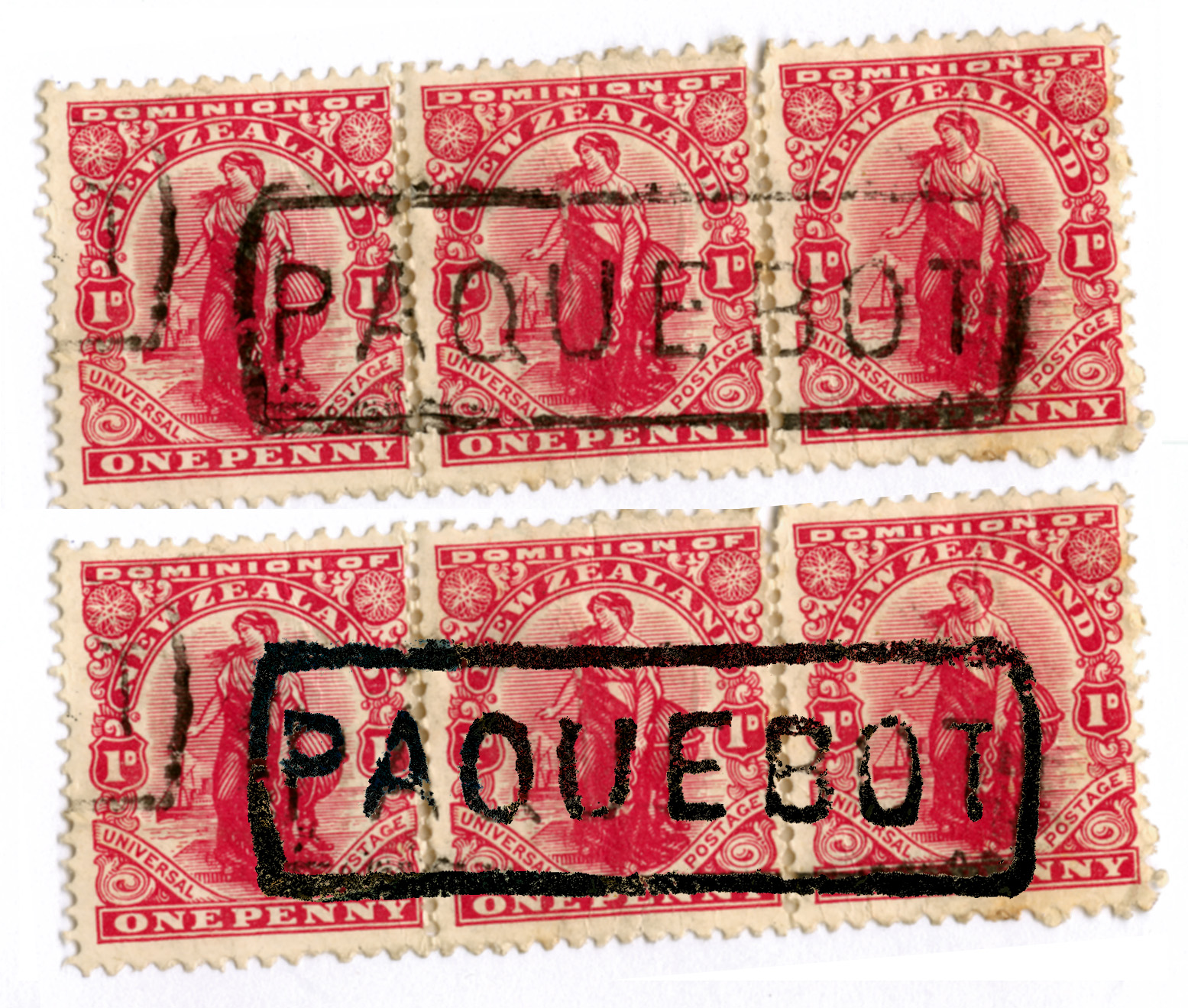1894 East London Paquebot Datestamp
Quote from Steve on June 26, 2023, 7:06 pmLast weekend. I paid the glorious sum of £2.50 to Peter Harvey of Military Mail for the strip of 3 New Zealand 1909 - 1925 1d carmines. See below. Neil has good material at reasonable prices. I believe he is well-known to Jamie! :>)
I thought at the time that the postmark on the the strip of New Zealand stamps looked like the early Durban rectangular boxed PAQUEBOT mark, something that I had seen on some very expensive covers and a subject I know nothing about. I bought it speculating that it was from Durban. It was certainly not the more common boxed rectangular PAQUEBOT mark supplied to Cape port post offices in the early 1900s. Bob Hill was standing next to me at the dealer table at the time I bought it and he remarked that he too thought it looked like Durban.
Now, if I was to bet on where it was from I would guess East London. I was looking for an example of the early Durban postmarks and was having difficulty finding one, my copies of Putzel being buried under a heap of 'stuff' in my office. The Cape cover below came up in my Paquebot box while I was rummaging around. It is very nice and it helped resolve the New Zealand strip of three's provenance.
The cover itself is the more interesting item. It was mailed from East London on 'MR 19 94' to Germany. Several strikes of a poor Hooded Circular datestamp and a strong PAQUEBOT mark has cancelled a bisected 4d, four 1ds and two ha'pennies (½d). The PAQUEBOT mark ties the bisected 4d to the cover. This PAQUEBOT mark is not recorded in 'The Paquebot Cancellation of the World and more...' nor is it listed in Robert Goldblatt's 'Postmarks of the CoGH'. The reverse shows London and Hamburg arrival marks. The cover is 'sick' with toning but its rare usage of a bisected 4d and its rare PAQUEBOT mark makes it extraordinary.
Of course, if Durban or Cape Town used the same Paquebot mark it could be from either of those places also. However, we know that when the common 'Omnibus' PAQUEBOT mark was supplied to Cape port post offices in the early 1900s, it was not supplied to Durban. This was because the Cape and Natal ran separate colonial postal systems that would not be amalgamated until Union in 1910. The two postal authorities were fiercely and jealously independent of each other. As a result they ordered and used different datestamps - and paquebot postmarks. For this reason, if the New Zealand strip is a Cape PAQUEBOT mark, I must rule Durban out. But not entirely. Early Paquebot marks are poorly documented. Who knows what we will learn once we study this maritime field (sea?) in more detail.
I am confident that I have shown enough to claim that this was used in a South African port, specifically a Cape one, possibly by a New Zealander en route to the battlefields of WW1. What I offer is not conclusive proof but it does indicate quite strongly that there is some merit in suggesting its from East London.
Here's my case. The cover shows us the Paquebot mark used in East London in 1894. It appears to be very similar to the New Zealand strip of three. I scanned both items and using Photoshop I copied the cover's PAQUEBOT mark and dropped Black into it using the Paint Bucket. You can see one of the steps, below. I then copied my recreated postmark and imported it into the scan of the New Zealand strip. I floated it over the New Zealand Paquebot mark and got a very good match. It would have been nice to have discovered that the cover was the last recorded use of the Hooded Circular datestamp in East London but it is not. That would have been asking too much of the Muse of Postal History. The Last Recorded use is '6 AU 94', some five months later.
Last weekend. I paid the glorious sum of £2.50 to Peter Harvey of Military Mail for the strip of 3 New Zealand 1909 - 1925 1d carmines. See below. Neil has good material at reasonable prices. I believe he is well-known to Jamie! :>)
I thought at the time that the postmark on the the strip of New Zealand stamps looked like the early Durban rectangular boxed PAQUEBOT mark, something that I had seen on some very expensive covers and a subject I know nothing about. I bought it speculating that it was from Durban. It was certainly not the more common boxed rectangular PAQUEBOT mark supplied to Cape port post offices in the early 1900s. Bob Hill was standing next to me at the dealer table at the time I bought it and he remarked that he too thought it looked like Durban.
Now, if I was to bet on where it was from I would guess East London. I was looking for an example of the early Durban postmarks and was having difficulty finding one, my copies of Putzel being buried under a heap of 'stuff' in my office. The Cape cover below came up in my Paquebot box while I was rummaging around. It is very nice and it helped resolve the New Zealand strip of three's provenance.
The cover itself is the more interesting item. It was mailed from East London on 'MR 19 94' to Germany. Several strikes of a poor Hooded Circular datestamp and a strong PAQUEBOT mark has cancelled a bisected 4d, four 1ds and two ha'pennies (½d). The PAQUEBOT mark ties the bisected 4d to the cover. This PAQUEBOT mark is not recorded in 'The Paquebot Cancellation of the World and more...' nor is it listed in Robert Goldblatt's 'Postmarks of the CoGH'. The reverse shows London and Hamburg arrival marks. The cover is 'sick' with toning but its rare usage of a bisected 4d and its rare PAQUEBOT mark makes it extraordinary.
Of course, if Durban or Cape Town used the same Paquebot mark it could be from either of those places also. However, we know that when the common 'Omnibus' PAQUEBOT mark was supplied to Cape port post offices in the early 1900s, it was not supplied to Durban. This was because the Cape and Natal ran separate colonial postal systems that would not be amalgamated until Union in 1910. The two postal authorities were fiercely and jealously independent of each other. As a result they ordered and used different datestamps - and paquebot postmarks. For this reason, if the New Zealand strip is a Cape PAQUEBOT mark, I must rule Durban out. But not entirely. Early Paquebot marks are poorly documented. Who knows what we will learn once we study this maritime field (sea?) in more detail.
I am confident that I have shown enough to claim that this was used in a South African port, specifically a Cape one, possibly by a New Zealander en route to the battlefields of WW1. What I offer is not conclusive proof but it does indicate quite strongly that there is some merit in suggesting its from East London.
Here's my case. The cover shows us the Paquebot mark used in East London in 1894. It appears to be very similar to the New Zealand strip of three. I scanned both items and using Photoshop I copied the cover's PAQUEBOT mark and dropped Black into it using the Paint Bucket. You can see one of the steps, below. I then copied my recreated postmark and imported it into the scan of the New Zealand strip. I floated it over the New Zealand Paquebot mark and got a very good match. It would have been nice to have discovered that the cover was the last recorded use of the Hooded Circular datestamp in East London but it is not. That would have been asking too much of the Muse of Postal History. The Last Recorded use is '6 AU 94', some five months later.
Uploaded files:




